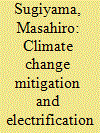|
|
|
Sort Order |
|
|
|
Items / Page
|
|
|
|
|
|
|
| Srl | Item |
| 1 |
ID:
112328


|
|
|
|
|
| Publication |
2012.
|
| Summary/Abstract |
An increasing number of mitigation scenarios with deep cuts in greenhouse gas emissions have focused on expanded use of demand-side electric technologies, including battery electric vehicles, plug-in hybrid vehicles, and heat pumps. Here we review such "electricity scenarios" to explore commonalities and differences. Newer scenarios are produced by various interests, ranging from environmental organizations to industry to an international organization, and represent a variety of carbon-free power generation technologies on the supply side. The reviewed studies reveal that the electrification rate, defined here as the ratio of electricity to final energy demand, rises in baseline scenarios, and that its increase is accelerated under climate policy. The prospect of electrification differs from sector to sector, and is the most robust for the buildings sector. The degree of transport electrification differs among studies because of different treatment and assumptions about technology. Industry does not show an appreciable change in the electrification rate. Relative to a baseline scenario, an increase in the electrification rate often implies an increase in electricity demand but does not guarantee it.
|
|
|
|
|
|
|
|
|
|
|
|
|
|
|
|
| 2 |
ID:
112332


|
|
|
|
|
| Publication |
2012.
|
| Summary/Abstract |
In a recent article Mabee et al. [2012, Energy Policy 40 (1), 480-489] describe the German legislation to promote renewable electricity generation (Erneuerbare-Energien-Gesetz). The erroneous assumption that an annual degression of feed-in tariffs for any given power generating facility are stipulated in the law leads to a wrong calculation of net present values of the revenue stream. Reduction of feed-in tariff rates only holds for new additions. There is however one exception in offshore wind energy where the operator can opt for a degression. The implications of the newly introduced option are discussed in this comment.
|
|
|
|
|
|
|
|
|
|
|
|
|
|
|
|
| 3 |
ID:
112304


|
|
|
|
|
| Publication |
2012.
|
| Summary/Abstract |
Numerous studies and market reports suggest that the solar photovoltaic markets rely heavily, if not entirely, upon governmental support policies at present. Unlike in other countries where these policies are enacted at a national level, the 50 states in the US pursue different policies in an attempt to foster the growth of renewable energy, and specifically solar photovoltaics. This paper provides an economic and financial analysis of the US federal and state level policies in states with solar-targeted policies that have Solar Renewable Energy Credits (SREC) markets. After putting a value on SRECs, this study further compares solar carve-outs with other incentives including the federal tax credit, net metering, and state personal tax credits. Our findings show that SREC markets can certainly be strong, with New Jersey, Delaware, and Massachusetts having the most potential. Despite their strong potential as effective renewable policies, the lack of a guaranteed minimum and the uncertainty attached are major drawbacks of SREC markets. However, the leveraging of this high value offers hope that the policies will indeed stimulate residential solar photovoltaic markets.
|
|
|
|
|
|
|
|
|
|
|
|
|
|
|
|
| 4 |
ID:
112325


|
|
|
|
|
| Publication |
2012.
|
| Summary/Abstract |
Internal European electricity markets are a target set by the European Union (EU) and under development at present. This article presents the findings of a Delphi study focusing on the prospects of European electricity markets. The main aim is to report the obstacles that participants in the survey felt were the most critical ones affecting competition in the European electricity markets of the future. The respondents were European electricity market specialists, and the themes of the survey ranged from transmission networks and electricity trade to demand flexibility. One of the key findings was shared concern over the adequacy of transmission network capacity in Europe. It was considered that technical issues, such as existing transmission network bottlenecks, are most likely to form obstacles to creating common European electricity markets if new capacity is not built quickly enough. It was seen by the panellists that electricity trading arrangements, whilst important, are unlikely to form a barrier to the development of an internal electricity market. It was noted that electricity trading issues have recently been the subject of development work in the EU.
|
|
|
|
|
|
|
|
|
|
|
|
|
|
|
|
| 5 |
ID:
112330


|
|
|
|
|
| Publication |
2012.
|
| Summary/Abstract |
Jacobson and Delucchi have recently put forward a detailed case in support of the claim that renewable energy sources can meet total world energy demand. The following argument is that this proposal is unsatisfactory, primarily because it does not deal effectively with the problems set by the variability of renewable energy sources, and also because its analysis of investment costs is inadequate.
|
|
|
|
|
|
|
|
|
|
|
|
|
|
|
|
| 6 |
ID:
112329


|
|
|
|
|
| Publication |
2012.
|
| Summary/Abstract |
In 2010, the Czech Republic was one of the states of the European Union, which met the indicative target for the share of renewable energy sources in gross electricity consumption. That year, gross electricity generation from renewable sources amounted to a total volume of 5851 GWh, which corresponds to 8.24% of gross electricity consumption in the Czech Republic in the given time period. The largest share of the total came from hydroelectric power plants (47.7%) and biomass power plants (25.8%), and a smaller share from photovoltaic power plants (10.5%), biogas power plants (8.7%) and wind farms (5.7%). Compared with 2009, the highest year-on-year growth came from photovoltaic power plants (527 GWh, 44.2%) and, as far as other renewable sources are concerned, electricity generation at hydroelectric power plants (360 GWh, 30.2%) and biogas power plants (184 GWh, 15.4%) rose more sharply as well.
|
|
|
|
|
|
|
|
|
|
|
|
|
|
|
|
| 7 |
ID:
112312


|
|
|
|
|
| Publication |
2012.
|
| Summary/Abstract |
Both renewable and nuclear energy can provide significant contributions to decarbonizing the electric sector. However, a grid employing large amounts of wind and solar energy requires the balance of the system to be highly flexible to respond to the increased variability of the net load. This makes deployment of conventional nuclear power challenging both due to the technical challenges of plant cycling and economic limits of reduced capacity factor. In the United States nuclear power plants generally provide constant, base load power and are most economic when operated at constant power levels. Operating nuclear power plants in load-following modes decreases the plants' annual energy output and increases the levelized cost of energy, decreasing economic competitiveness.
One possible solution is to couple thermal energy storage to nuclear power plants. This would enable the reactor to remain at nearly constant output, while cycling the electrical generator in response to the variability of the net load. This paper conceptually explores combinations of wind, solar, and nuclear that can provide a large fraction of a system's electricity, assuming the use of thermal energy storage that would allow nuclear power to provide load following and cycling duty while operating at a constant reactor power output.
|
|
|
|
|
|
|
|
|
|
|
|
|
|
|
|
| 8 |
ID:
112308


|
|
|
|
|
| Publication |
2012.
|
| Summary/Abstract |
Ireland recorded significant growth in energy-related carbon emissions from 1990 to 2007 as the country underwent rapid economic development. Using the LMDI decomposition analysis method, this paper aims to identify and analyse the driving forces of CO2 emissions in eleven final energy consuming sectors. This multi-sectoral analysis is based on four economic sectors, the residential sector and gives a detailed representation of transport in keeping with UNFCCC recommendations. Scale, structure and intensity effects are explored and substantial heterogeneity in sectoral performance is observed. Scale growth in economic and transport activity was considerable. Some improvements in energy intensity were recorded in the economic sectors. In transport, increases in intensity contributed to a significant increase in emissions, while energy intensity decreased in the residential sector. The declining emissions coefficient of electricity was important in limiting emissions but renewable energy has been slow to penetrate the demand side. The results have relevance in considering development paths and can aid in identifying policy measures required to address the key driving forces of emissions in the sectors. The rapid increase in transport emissions in particular raises concerns of future lock-in to a higher emissions trajectory.
|
|
|
|
|
|
|
|
|
|
|
|
|
|
|
|
| 9 |
ID:
112306


|
|
|
|
|
| Publication |
2012.
|
| Summary/Abstract |
Biomass gasification is expected to be an attractive option among other competitive applications of biomass conversion for bio-energy. This study analyzes economic feasibility of biomass gasification power generating plants in three selected communities (Ignace, Nipigon and Kenora) of northwestern Ontario. The major variables considered in the model are harvesting and handling costs, logistic costs for biomass feedstock delivery and storage, capital costs of power plant by scales, operation and maintenance costs, labor costs, capital financing costs and other regulatory costs. GIS analysis was undertaken to estimate the distance class matrix to apportion the biomass feedstock supply side from different forest management units. Total cost per MW h power production at a 50 MW scale ranges from CAD 61.89 to CAD 63.79. Total cost per unit of electricity production decreases significantly as plant capacity increases due to economy of scale in the production system. Further, the locations of plants explained the cost variability.
|
|
|
|
|
|
|
|
|
|
|
|
|
|
|
|
| 10 |
ID:
112293


|
|
|
|
|
| Publication |
2012.
|
| Summary/Abstract |
Rising and sometimes volatile fuel prices pose a challenge for rural organizations reliant on long distance transport. To understand the coping mechanisms used by such organizations, we survey rural business strategies in Israel, where fuel prices are high and urban development is concentrated in the country's geographic center. The businesses surveyed are operated by kibbutzim, historically collective communities that are now in various stages of privatization. Analysis of the 'transport strategies' employed by nearly 100 organizations in three regions of varying remoteness and isolation shows that firms rely on distinct strategies such as localization and high value density. Localization was found to be prevalent in all regions, as it requires little capital investment. Strategies exploiting high value density, including information-based services, were prevalent in remote and isolated regions where sensitivity to transport costs is acute. Non-remote firms were less inclined toward strategic adaptation, preferring non-disruptive changes such as cheaper shipping modes. The development implications of these transport strategies are consistent with rural economic trends observed throughout the developed world. If transport costs continue to rise, rural firms may shrink the radius of their sales and labor pools, or search for more lucrative products to reduce their relative transport costs.
|
|
|
|
|
|
|
|
|
|
|
|
|
|
|
|
| 11 |
ID:
112321


|
|
|
|
|
| Publication |
2012.
|
| Summary/Abstract |
The aim of the present paper is to characterize and analyze the emergence of the biodiesel industry in Brazil, and provide an assessment of the extent to which the goals established by the National Biodiesel Production and Usage Program have been reached. In relation to the goal of including biodiesel within the Brazilian energy matrix, the program can be seen to be responding dynamically and ahead of schedule. In 2010, the B5 blend was already part of the diesel consumed in Brazil, with 81% of the biodiesel coming from soybean oil and 14% from beef tallow. By contrast, the plans to diversify the feedstocks used to produce biodiesel and improve production in the poorest regions of Brazil have failed to prosper. Regarding the goal of fostering social inclusion by encouraging the participation of family-based farming, this has been partially achieved. Finally, the goal of cost-efficiently producing biodiesel is far from being achieved. The economic feasibility of the production and use of biodiesel in Brazil can be questioned since it is still strongly supported by tax incentives and production and marketing subsidies.
|
|
|
|
|
|
|
|
|
|
|
|
|
|
|
|
| 12 |
ID:
112327


|
|
|
|
|
| Publication |
2012.
|
| Summary/Abstract |
The goal of this study is to evaluate the life cycle performance of two alternative pathways to biofuels in the shipping industry: the 'diesel route' and the 'gas route'. The diesel route comprises of a shift from heavy fuel oil to marine gas oil and then a gradual shift to biodiesel, whereas the gas route comprises of a shift to liquefied natural gas and then a gradual shift to liquefied biogas. The two routes are assessed in a case study for the ferry traffic between the Swedish mainland and the island Gotland. Life cycle assessment (LCA) is used to evaluate the environmental performance with the functional unit chosen to be one year of ro-pax ferry service, including both passenger and goods transportation. The gas route is indicated to have better overall environmental performance than the diesel route. Furthermore, use of biofuels is illustrated as one possible measure to decrease the global warming impact from shipping, but to the expense of greater environmental impact for some other impact categories. As an example, the global warming potential (GWP100) was shown to decrease with the use of biofuels in this study, while the eutrophication potential and the primary energy use increased.
|
|
|
|
|
|
|
|
|
|
|
|
|
|
|
|
| 13 |
ID:
112314


|
|
|
|
|
| Publication |
2012.
|
| Summary/Abstract |
The purpose of this study is to investigate the future electricity saving potential of China's chemical industry. Applying cointegration, we find that there is a long-run equilibrium relationship between electricity intensity and technology, labor, electricity prices and industry structure. The result shows that more active electricity saving policies are objectively required to be implemented in order to reduce the electricity intensity in China's chemical industry as well as to shrink future electricity saving potential. For this purpose, we have adopted a scenario analysis method to predict the electricity intensity and the electricity saving amount under two different scenarios. It is found that energy conservation policy provides a continuous impetus for reducing the electricity saving potential. In terms of electricity intensity of the chemical industry, China's intensity is approaching the level in Japan, with the gap narrowing significantly by the year 2020. Finally, based on the elasticities obtained in the long-term equilibrium equation, the paper suggests a range of future policy priorities and directions.
|
|
|
|
|
|
|
|
|
|
|
|
|
|
|
|
| 14 |
ID:
112292


|
|
|
|
|
| Publication |
2012.
|
| Summary/Abstract |
Australia is heavily dependent on coal for electricity generation. The Renewable Energy Target has spurred growth in the utilization of renewable energy sources, with further growth expected into the future. Australia's strongest renewable energy sources are generally distant from the transmission network in resource 'basins'. Investment is needed to augment the transmission network to enable delivery of electricity from these sources to consumers. Considerable economies of scale flow from anticipating the connection of numerous generators in an area over time and sizing augmentations accordingly.
Following a lengthy rulemaking process, the National Electricity Rules were recently amended by a new rule, designed to facilitate the construction of such efficiently sized augmentations. However, the new rule is more conservative than initially envisaged, making little substantive change to the current frameworks for augmentation and connection.
This paper outlines these frameworks and the rulemaking process and identifies the key debates surrounding the rule change are identified. This paper then provides a detailed analysis of the new rule, concluding that it is defective in a number of respects and is unlikely to result in the efficient and timely augmentation of the network needed to unlock the potential of Australia's strongest renewable energy resources.
|
|
|
|
|
|
|
|
|
|
|
|
|
|
|
|
| 15 |
ID:
112319


|
|
|
|
|
| Publication |
2012.
|
| Summary/Abstract |
The electricity sector has to undergo a large-scale transformation process to reduce the threat of climate change. Wind power has a strategic role to play in this process. This paper makes a preliminary assessment of the types and numbers of engineers required to sustain a large-scale expansion of offshore wind energy in the EU and draws lessons for universities. A variety of competences are required, including (a) deep competences in many fields (electrical and mechanical engineering, but also engineering physics and civil engineering); (b) integrative competences within engineering (e.g., mechanical and electrical engineering) and between engineering and non-engineering fields (e.g., meteorology and logistics). A large number of engineers are required. A rough estimate indicates a need for more than 10 000 new engineers until 2020. The nature and volume of the competences required raise serious questions for the scale and organization of training programmes at universities.
|
|
|
|
|
|
|
|
|
|
|
|
|
|
|
|
| 16 |
ID:
112316


|
|
|
|
|
| Publication |
2012.
|
| Summary/Abstract |
As the Copenhagen Conference of Parties (COP) failed to negotiate a binding Post-Kyoto agreement, an alternative is proposed based on the Copenhagen Accord (CA). The CA, as endorsed by COP16 in Cancun, aims to combat global warming with differentiated reduction targets of greenhouse gas emissions and by mobilizing resources supporting adaptation and carbon-free technology in developing countries (DCs). Using a special version of MERGE, we study the global implications of the CA postulating extensions of the Accord in the direction of Technology Transfer Protocols (TTPs). We assess scenarios needed to reach sustainable climate targets under such Protocols. It is shown that without binding commitments for DCs, the warming target of 2 °C will be exceeded with a probability above 50%, even if Annex B countries eliminate their emissions. However, moderate commitments of DCs (when they reach sufficient economic development), make the 2 °C scenario feasible. TTPs combined with binding emission reduction targets thus provide a mechanism to reduce climate change damages, and may generate significant secondary benefits. For example, the reduced tax-subsidy scenario (RTS20) has 77% to 40% chances to remain below 2 °C of warming and an undiscounted cumulative gross domestic product (GDP) cost of 0.75% relative to baseline (not accounting for the benefits of avoided damages).
|
|
|
|
|
|
|
|
|
|
|
|
|
|
|
|
| 17 |
ID:
112323


|
|
|
|
|
| Publication |
2012.
|
| Summary/Abstract |
The diversity of greenhouse gas (GHG) accounting methodologies currently utilized by cities around the world make meaningful comparisons of their emissions almost impossible. Consequently, the 2010 United Nations International Standard for Determining Greenhouse Gas Emissions for Cities promotes a "harmonized protocol for quantifying the GHG emissions attributable to cities and local regions." The UN's common standard has important implications for comparison, benchmarking and policy assessment related to energy policies. This paper uses Hong Kong as a case study to illustrate these implications. Hong Kong's per capita contribution to GHG emissions are among the highest in the world, yet the local government's official statistics indicate emissions that are far below those reported by most affluent economies. This discrepancy arises from a reporting methodology that does not require inclusion of GHG emissions linked to consumption of imported goods or emissions from aviation and shipping. The Hong Kong case reveals that current inventories do not provide sufficient information to guide policymaking related to energy and climate change. They also do not provide adequate information for comparing policies of cities internationally. Alternative emissions-reporting standards that focus more on pollution from consumption will create avenues for more effective climate-related policies.
|
|
|
|
|
|
|
|
|
|
|
|
|
|
|
|
| 18 |
ID:
112288


|
|
|
|
|
| Publication |
2012.
|
| Summary/Abstract |
In the past two decades, rapid population and economic growth on the U.S.-Mexico border has spurred a dramatic increase in electricity demand. In response, American energy multinationals have built power plants just south of the border that export most of their electricity to the U.S. This development has stirred considerable controversy because these plants effectively skirt U.S. air pollution regulations in a severely degraded international airshed. Yet to our knowledge, this concern has not been subjected to rigorous scrutiny. This paper uses a suite of air dispersion, health impacts, and valuation models to assess the human health damages in the U.S. and Mexico caused by air emissions from two power-exporting plants in Mexicali, Baja California. We find that these emissions have limited but nontrivial health impacts, mostly by exacerbating particulate pollution in the U.S., and we value these damages at more than half a million dollars per year. These findings demonstrate that power-exporting plants can have cross-border health effects and bolster the case for systematically evaluating their environmental impacts.
|
|
|
|
|
|
|
|
|
|
|
|
|
|
|
|
| 19 |
ID:
112324


|
|
|
|
|
| Publication |
2012.
|
| Summary/Abstract |
The Renewable Portfolio Standard (RPS) of the State of Illinois specifies a schedule for the fraction of electricity produced from wind to be phased in through 2025. The price of electricity due to implementation of RPS in order to achieve a six-year payback on investment on new wind farms was estimated for six scenarios that examined the effect of electricity consumption growth rate, production tax credit of $0.022/kW h or unrestricted investment tax credit of 30%, and projected changes in installed project costs. In all cases, the electricity price was found to be dominated by the installed project cost (capital cost). Thus, any policy that affects the capital cost directly or indirectly would have a significant effect on the electricity price. Whereas investment tax credit has a direct effect, policies that encourage technology improvement and improve transmission lines would have a similar effect of lowering the capital cost. Carbon tax, on the other hand, would increase the electricity price to the consumers, although it offers other benefits.
|
|
|
|
|
|
|
|
|
|
|
|
|
|
|
|
| 20 |
ID:
112310


|
|
|
|
|
| Publication |
2012.
|
| Summary/Abstract |
Considering household appliance automation for reduction of household peak power demand, this study explored aspects of the interaction between household automation technology and human behaviour. Given a programmable household appliance switching system, and user-reported appliance use times, we simulated the load reduction effectiveness of three types of algorithms, which were applied at both the single household level and across all 30 households. All three algorithms effected significant load reductions, while the least-to-highest potential user inconvenience ranking was: coordinating the timing of frequent intermittent loads (algorithm 2); moving period-of-day time-flexible loads to off-peak times (algorithm 1); and applying short-term time delays to avoid high peaks (algorithm 3) (least accommodating). Peak reduction was facilitated by load interruptibility, time of use flexibility and the willingness of users to forgo impulsive appliance use. We conclude that a general factor determining the ability to shift the load due to a particular appliance is the time-buffering between the service delivered and the power demand of an appliance. Time-buffering can be 'technologically inherent', due to human habits, or realised by managing user expectations. There are implications for the design of appliances and home automation systems.
|
|
|
|
|
|
|
|
|
|
|
|
|
|
|
|
|
|
|
|
|